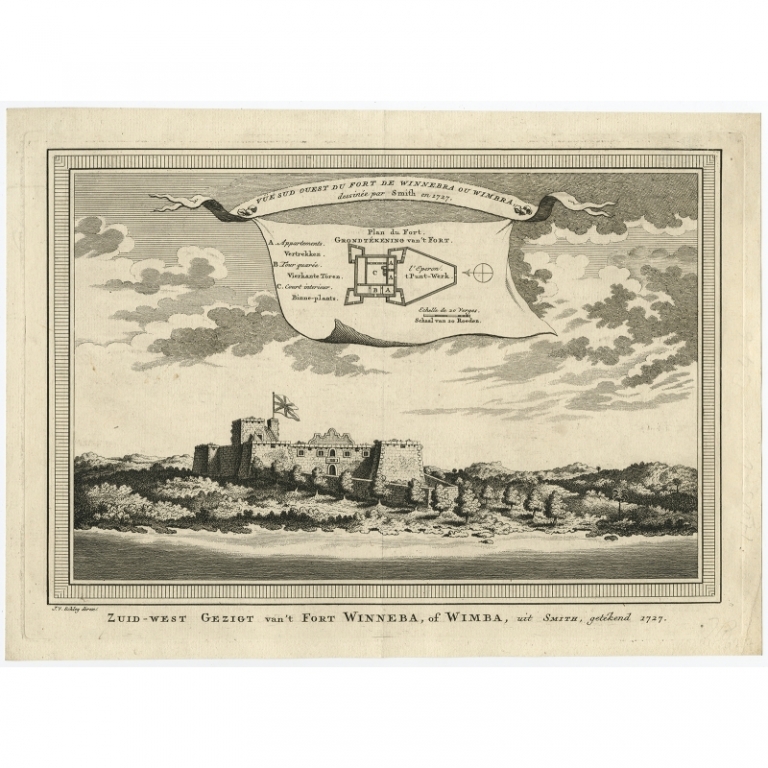 |
Bondoukou, the capital city of Gyaaman.
|
| Despite leading the Ashanti to their largest military victory since Osei Tutu after only three years on the golden stool, the remainder asantehene Osei Bonsu's reign was far from peaceful. From 1811 until 1819, the Ashanti would be enter into two other major wars. |
 |
Illustration of Kumasi, with the wall of the Aban Dan appearing in the bottom-left corner.
|
The first of these wars, which lasted from 1811 until 1816, pitted the Ashanti against the Fante Confederacy and a faction of Akyem and Denkyira rebels. The Fante had long been the Ashanti's most powerful rival, but Osei Bonsu had forced them to submit to Fante vassalage after a shocking Ashanti victory at the Battle of Abura in 1806. Despite losing many of their most experienced and capable officers at Abura, the Fante quickly rebuilt their ranks into a respectable army. In 1811, the Fante decided to reassert their independence by attacking Elmina and Accra, both controlled by Ashanti allies. While the Ashanti won the early stages of the war, the Fante Twafohene (military leader) switched to a strategy of asymmetric warfare. This new strategy was very effective and, combined with an outbreak of smallpox in the Ashanti army, severely weakened Ashanti control over Fanteman. However, in 1814, the British changed tactics. Instead of trying to fight the Fante themselves, the Kontihene decided that a better strategy was to cut off their supplier. The British Company of African merchants, despite having agreed to a treaty recognizing Ashanti sovereignty over the southern coast, supplied the Fante with arms and ammunition. |
| Fort Winneba, the fort that Osei Bonsu's army seized in 1814 |
In 1814, the Ashanti decided to force the British not to sell weapons to the Fante. They successfully captured the British fortress Winneba using tactics they had practiced at a replica European castle in Kumasi, known as the Aban Dan. The British were defeated and the forts governor executed. After the battle of Winneba, the British agreed to half weapons sales to the Fante. From there, Fante supplies dwindled, and they sued for peace in 1816. The treaty signed between the Fante, British, and Ashanti stipulated full Ashanti access to the coast, exclusive Ashanti weapons trading rights during wartime, and a recognition of Ashanti sovereignty over the coastal peoples. However, the Fante did successfully prove to the Ashanti that they could not be governed easily. The war reinforced that the Fante Confederacy would continue to exist as a separate state, albeit as a subject of the asantehene.
In 1817, tensions arose on the other side of the Ashanti empire. Under the rule of Queen Ama Tamia and her brother Kwadwo Adinkra, the kingdom of Gyaaman had created a replica of the Ashanti golden stool for their own royal family. This stool was a brazen challenge to Ashanti authority, as well as an announcement that the state would no longer pay tribute to their Ashanti neighbors. Enraged, Osei Bonsu mobilized an army to march north and crush Gyaaman. After a hard fought battle on the Tain river, the Ashanti emerged victorious and later crushed the Gyaaman army at Nkoransa. The king and queen were either killed by the Ashanti or committed suicide. Gyaaman was ransacked, with almost half of its population either killed or sold into slavery. With these two victories, Osei Bonsu solidified his position as the most capable Ashanti military monarch since Osei Tutu himself.
 |
| The Ashanti Empire at its height in 1818, featuring roads. |




No comments:
Post a Comment